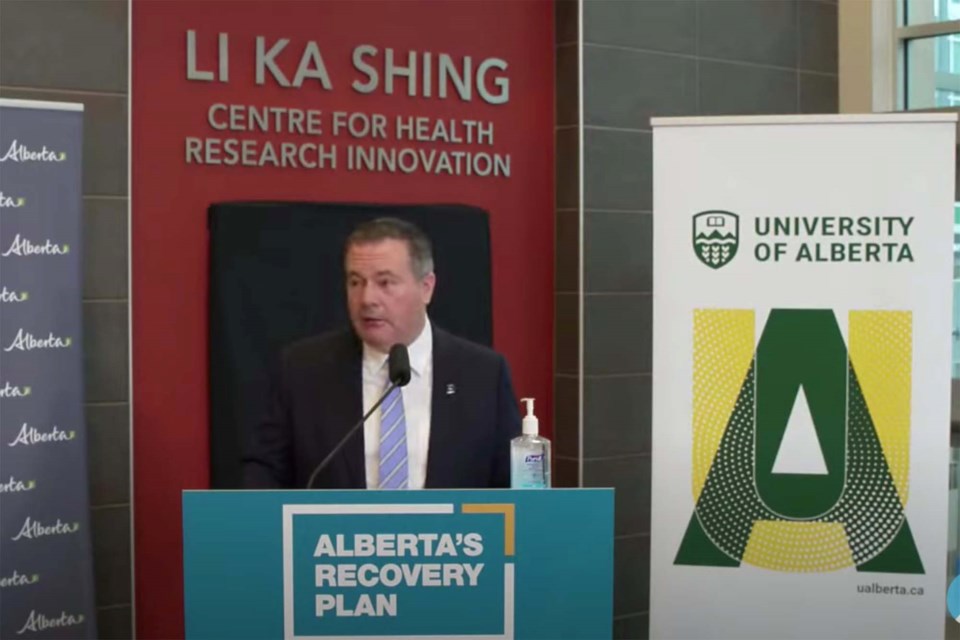ST. ALBERT: Domestic vaccine development companies could see millions from the province if federal financing comes through.
On Dec. 1 Premier Jason Kenney announced up to $81.2 million for vaccine development and manufacturing, contingent on federal government financing, to four proposals selected after an independent third-party review.
“Alberta's government identified pharmaceutical and life sciences as a key target sector in the economic recovery plan.
“Today, we're putting our money where our mouth is when it comes to growing this industry and making Alberta a global leader in innovation and the full spectrum of vaccine development," said Kenney during the press conference.
The majority of the funding, up to $55.1 million, will go to the University of Alberta’s Li Ka Shing Institute of Virology to support vaccine portfolio development, support for Alberta cell-therapy manufacturing, a level three biosafety lab, and a structural biology facility.
“The funding will address the need for vaccine development here but will also support the broader pharmaceutical and life sciences sector in Alberta helping to create new jobs and opportunities for economic diversification,” said Kenney.
In a press statement, the province said it will work with the U of A to secure funding from the $2.2 billion over seven years the federal government proposed back in July of this year. The total amount of funding from the province will be dependent on how much funding the federal government provides.
The province has also committed to funding 10 per cent of the other three proposals contingent on federal support.
This includes $15.5 million to Entos Pharmaceuticals, which has plans to establish a commercial manufacturing facility in Edmonton.
Applied Pharmaceutical Innovation could receive $5.6 million from the province to build integrated research, commercialization, and manufacturing clusters to ensure the security of the supply of critical medicines at commercial volumes.
Andrew MacIsaac, CEO of Applied Pharmaceutical Innovation, said this funding sends a critical message to federal partners about how Alberta sees its role within the supply chain.
“A lot of the investments in vaccine production around the world have come from a federal level, working in conjunction with the regional areas. I think that this is a great first step … it's the first step in a road to really boosting the life sciences economy in the province,” MacIsaac said in response to a reporter’s question.
Finally, Northern RNA would see $5 million to help build the RNA ecosystem in Alberta.
Kenney told a reporter this funding is important because of the vaccine nationalism seen throughout the COVID-19 pandemic. Jurisdictions such as the U.S received vaccines three to five months ahead of Canada, which had a detrimental impact on the country.
“There were many Canadians who otherwise could have prevented severe outcomes had they been vaccinated that weren't. This can have very real life-and-death consequences. And we need to learn from that experience,” said Kenney.
In response to a reporter’s question about the funding during a Dec. 1 press conference, NDP Health Critic David Shepherd said he thinks we have a lot of opportunities in the province and when it comes to the knowledge field and manufacturing vaccines in the province, this could be a good part of economic diversification.
Alberta’s pharmaceutical and life sciences industry is the fourth largest in Canada. The province is reporting that in 2019, Alberta’s pharmaceutical and life sciences industry attracted $430 million in private capital investment, which generated $824 million in revenue and supported more than 15,000 high-paying jobs.
The pharmaceutical and therapeutics sector is a massive industry. In 2019 worldwide revenues for the sector were $1.25 trillion, with revenues projected to grow to $1.5 trillion by 2023.
Shepherd, however, does have concerns.
“The small amount of funding that the government is putting in, in this case to institutions like the University of Alberta, pales in comparison to the drastic cuts they have forced on to those institutions.”



